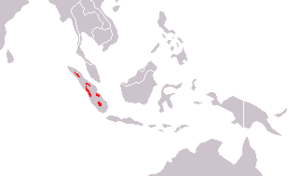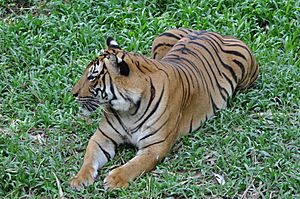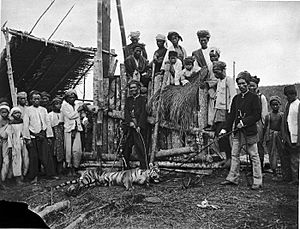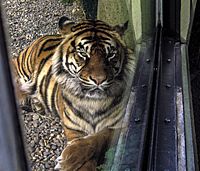Sumatran tiger facts for kids
Quick facts for kids Panthera tigris sondaica |
|
|---|---|
 |
|
| Sumatran tiger in the Tierpark Berlin | |
| Scientific classification | |
| Kingdom: | Animalia |
| Phylum: | Chordata |
| Class: | Mammalia |
| Order: | Carnivora |
| Suborder: | Feliformia |
| Family: | Felidae |
| Subfamily: | Pantherinae |
| Genus: | Panthera |
| Species: | P. tigris |
| Subspecies: | P. t. sondaica |
| Trionomial name | |
| Panthera tigris sondaica | |
 |
|
| Distribution of the Sumatran tiger | |
The Sumatran tiger is a special kind of tiger found only on the Indonesian island of Sumatra. It's the only tiger left in the Sunda Islands. Sadly, other tigers from these islands, like the Bali tiger and Javan tiger, are now extinct.
Scientists have studied the DNA of Sumatran tigers. They found that these tigers are different from tigers living on the mainland of Asia. In 2017, experts decided to group all tigers from Indonesia, both living and extinct, under the scientific name Panthera tigris sondaica.
Contents
What Makes Sumatran Tigers Special?
Sumatran tigers have some unique features. Their fur is darker than other tigers. They also have wider stripes. These stripes sometimes break up into spots near their ends. You can even see small, dark spots between the regular stripes on their back, sides, and hind legs. They have more stripes than other tiger types.
Male Sumatran tigers have a noticeable ruff, which is a mane-like fur around their neck. This ruff is especially big on them.
Sumatran tigers are among the smallest tigers in the world.
- Male tigers are about 2.2 to 2.55 meters (7.2 to 8.4 feet) long from head to body. They weigh around 100 to 140 kilograms (220 to 309 pounds).
- Female tigers are a bit smaller. They are about 2.15 to 2.30 meters (7.1 to 7.5 feet) long. They weigh 75 to 110 kilograms (165 to 243 pounds).
Where Do Sumatran Tigers Live?
Sumatran tigers live in small groups across the island of Sumatra. You can find them from sea level in coastal forests, like in Bukit Barisan Selatan National Park, up to 3,200 meters (10,500 feet) high in mountain forests, like in Gunung Leuser National Park.
They live in about 27 areas that are larger than 250 square kilometers (97 square miles). These areas cover a total of 140,226 square kilometers (54,142 square miles). About one-third of these areas are inside protected parks.
Sumatran tigers prefer forests in lowlands and hills. In these areas, up to three tigers might live in a space of 100 square kilometers (39 square miles). They don't use areas like farms or human-made landscapes as much.
In 1978, there were thought to be about 1,000 Sumatran tigers. By 2011, the largest group of tigers, about 165–190 individuals, lived in Kerinci Seblat National Park. This park has the most tigers on the island. As of 2017, the total number of Sumatran tigers was estimated to be around 618.
How Do Sumatran Tigers Live?

Sumatran tigers mostly live in natural, untouched forests. They don't often use areas with tree farms, like those for acacia or oil palm, even if they are nearby.
Within natural forests, tigers tend to stay in higher places. They prefer areas with less rain, far from the edge of the forest, and closer to the center. They like forests with thick plants on the ground and steep slopes. They try to avoid areas where humans are active, like settlements or logging sites.
In tree farms, they might use areas closer to water. They also prefer older plants with more fallen leaves and thicker plants under the main trees. Tiger sightings in oil palm or rubber farms are rare. Tigers need enough plant cover on the ground to hide and feel safe. Without it, they are more easily found by humans. Human activities like logging or settlements in forests negatively affect where tigers live.
Studies in southern Riau showed very few prey animals and a low number of tigers in swamp forests. However, in Tesso Nilo National Park, the number of tigers increased from 0.90 tigers per 100 square kilometers in 2005 to 1.70 tigers per 100 square kilometers in 2008.
In Bukit Barisan Selatan National Park, scientists found nine types of prey animals that tigers eat. These include great argus birds, pig-tailed macaque monkeys, Malayan porcupines, Malayan tapirs, banded pigs, and different kinds of deer like Sambar deer.
What Threats Do Sumatran Tigers Face?
The biggest dangers to Sumatran tigers are:
- Habitat loss: Forests are being cut down to make way for palm oil and acacia tree farms.
- Lack of prey: There aren't enough animals for tigers to hunt and eat.
- Illegal trade: Tigers are hunted illegally for their body parts, which are sold, mostly within Indonesia.
Tigers need large, connected forest areas to survive. Between 1985 and 1999, the forest in Bukit Barisan Selatan National Park shrank by 2% each year. A total of 661 square kilometers (255 square miles) of forest disappeared inside the park. Most of this forest was cleared for farming. This means that by 2010, much of the park was expected to be farmland. Tigers tend to avoid the edges of forests where human activity is high.
The largest tiger group in Kerinci Seblat National Park is also in danger. Forests around the park are being cut down quickly. This happens because more people need natural resources. Also, the government encourages more tree farms and logging, which can lead to forest fires. Many tigers in the park have moved to the center where conservation efforts are stronger. However, the lowland forests on the outskirts, which are good tiger habitats, are still heavily logged. This causes tiger numbers to drop there.
More farms also mean more greenhouse gas emissions, which contribute to climate change. This adds more pressure on endangered animals. If tigers move north because of climate change, they might have more conflicts with people. From 1987 to 1997, Sumatran tigers reportedly killed 146 people and at least 870 farm animals.
Poaching is a big problem. In 1997, about 53 tigers were killed by poachers in northern Sumatra. Their body parts were sold. Farmers sometimes kill tigers to protect their livestock and then sell the tiger parts to shops or pharmacies. In 2006, surveys found tiger parts like skins, teeth, bones, and whiskers being sold in markets. Tiger bones were the most expensive. There is also proof that tiger parts are smuggled out of Indonesia. In 2005, over 140 kilograms (309 pounds) of tiger bones and 24 skulls were found in Taiwan, shipped from Jakarta.
In 2013–2014, poaching increased in Kerinci Seblat National Park. Many more snare traps were found and removed. It's hard to tell if efforts to stop poaching are working, even with millions of dollars spent on conservation.
How Are Sumatran Tigers Being Protected?
The Sumatran tiger is listed under CITES Appendix I, which means hunting them is strictly forbidden. Indonesia also prohibits hunting tigers.
In 1994, Indonesia created a plan to save Sumatran tigers. The Sumatran Tiger Project (STP) started in 1995. Its goal was to help wild Sumatran tigers survive long-term. It also gathered information about tigers to help manage their populations. By 1999, the STP teams had checked 52 possible tiger habitats. Only 15 were healthy enough for tigers. The STP also started a program to help local communities and authorities deal with tiger-human conflicts.
In 2007, the Indonesian Forestry Ministry and Safari Park teamed up with the Australia Zoo. They work together to protect Sumatran tigers and other endangered animals. This program includes protecting tigers in the wild, reducing conflicts between tigers and humans, and helping injured tigers return to their natural home.
Indonesia is working harder to protect wildlife. In 2009, Indonesia's president promised to greatly reduce deforestation. New rules were made to ensure that land use plans are good for the environment.
Between 2005 and 2015, about $210 million was spent on tiger protection efforts. This money supported forest ranger patrols and other law enforcement activities. The Global Tiger Recovery Plan aims to double the number of wild tigers by 2020. In 2016, the Batu Nanggar Sanctuary opened in North Padang Lawas Regency to help protect Sumatran wildlife.
Surveys show that many people are willing to pay more for products that help protect Sumatran tigers. This is a good sign for conservation efforts.
Sumatran Tigers in Zoos

As of 2013, about 375 Sumatran tigers lived in zoos around the world. About 50 of them were in 14 zoos in Australia and New Zealand. All these tigers came from just 15 original tigers. Some cubs had problems with their balance and eyes when they were born. These problems usually went away by the time they were two years old. This issue is likely due to their close family relations and inbreeding.
See also
 In Spanish: Tigre de Sumatra para niños
In Spanish: Tigre de Sumatra para niños
-
- Prehistoric tigers: Panthera tigris soloensis
- Panthera tigris trinilensis
- Panthera tigris acutidens





